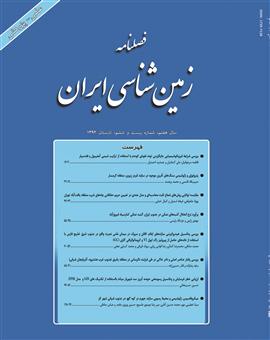پترولوژی و ژئوشیمی سنگ¬های آذرین موجود در سازند قرمز زیرین، منطقه گرمسار
محورهای موضوعی :
1 - ر دانشکده علوم زمین، دانشگاه شاهرود، ش
کلید واژه: پترولوژی ژئوشیمی حوضه کششی پشت کمان اولیه سازند قرمز زیرین گرمسار.,
چکیده مقاله :
در داخل سازند قرمز زیرین در منطقه گرمسار، توده های بازیک نیمه عمیق متعددی برونزد دارند. این توده ها دارای ترکیبات گابرویی تا دیوریتی بوده و بافت های گرانولار، اینترگرانولار، افیتیک و ساب افیتیک دارند. کانی های اصلی این سنگ ها را پلاژیوکلاز، کلینوپیروکسن اوژیتی، آمفیبول و بیوتیت و کانی های فرعی و عارضه ای آن ها را الیوین، فلوگوپیت، آلکالی فلدسپار، آپاتیت، مگنتیت و اسفن تشکیل می دهند. از کانی های ثانویه آن ها نیز می توان به سرپانتین، زئولیت، کلریت، سریسیت، پرهنیت، اسفن، اورالیت، کوارتز و کلسیت اشاره کرد. این سنگ ها در نمودارهای رده بندی شیمیایی در قلمرو گابرو- دیوریت و سری آلکالن قرار می گیرند. روندهای ژئوشیمیایی نمونه ها در نمودارهای تغییرات عناصر اصلی و کمیاب در مقابل ضریب تفریق و نمودارهای عناصر ناسازگار- ناسازگار و ناسازگار- سازگار، بیانگر ارتباط تفریقی بین نمونه هاست. در نمودارهای بهنجار شده به کندریت و گوشته اولیه، غنی شدگی از LREEs و LILEs، تهی شدگی از HREEs، نبود نابههنجاری Eu، وجود نابههنجاری مثبت در عناصرK Sr , Rb, Ba, در همه نمونه ها و تهی شدگی شدید برخی نمونه ها از Nb و Ta و فقدان تهی شدگی آن ها از Ti و P از ویژگی های بارز این سنگ هاست. این امر بیانگر آلایش پوسته ای ماگمای مافیک گوشته ای سازنده این سنگ هاست. این سنگ ها فاقد ویژگی های شاخص سنگ های وابسته به فرورانش بوده و بیشتر خصوصیات ماگماهای بازالتی آلکالن محیط های پشت کمانی (BAB) اولیه را نشان می دهند. نمودارهای مختلف تعیین محیط تکتونوماگمایی نیز وابستگی آن ها به بازالت های پشت کمانی را تأیید میکنند. بهنظر می رسد که ماگمای بازیک اصلی و اولیه این سنگ ها، در یک محیط کششی پشت کمانی اولیه و از ذوب بخشی یک منبع گوشته ای غنی شده، در زیر لیتوسفر قاره ای ایران مرکزی در زمان الیگوسن پسین به وجود آمده و در بخش پایین سازند قرمز زیرین نفوذ کرده باشد.
Numerous shallow depth basic intrusions crops out in the Lower Red Formation in Garmsar area. These intrusions have gabbro-dioritic compositions and granular, intergranular, ophitic and subophitic textures. Plagioclase, augitic clinopyroxene, amphibole and biotite are their main minerals and olivine, phlogopite, alkali feldspar, apatite, magnetite and sphene are their minor and accessory minerals. Their secondary minerals composed of serpentine, zeolite, chlorite, sericite, prehnite, sphene, uralite, quartz and calcite. These rocks plotted in gabbro-diorite realm in chemical classification diagrams. Geochemical trends of samples in major and trace elements variation diagrams versus differentiation index and in incompatible-incompatible and incompatible-compatible diagrams indicate the liquid line of descent and differentiation relations between samples. In the chondrite and primitive mantle normalized diagrams, enrichment in LREEs and LILEs, depletion in HREEs, absence of Eu anomaly, positive anomalies in K, Ba, Rb and Sr in all samples and strongly depletions in Nb and Ta in some samples and absence of depletion in Ti and P, are the characteristics features of these rocks. This indicates the crustal contamination of the mafic mantle magma formed these rocks. These rocks rather have the features of proto-back-arc basin (BAB) alkaline basaltic magmas, not the characteristics of the subduction related rocks. The dependence of these rocks to the back-arc basin basalts can be confirmed by different tectonic setting discrimination diagrams. It seems that the primary basic magma of these rocks has been generated from partial melting of an enriched mantle source under the continental lithosphere of Central Iran in an extensional proto-back-arc basin, during Late Oligocene time and intruded in lower part of Lower Red Formation.


